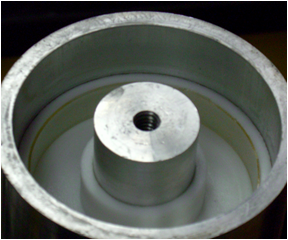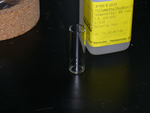
Washing the LCE after preparation removes unreacted components from the elastomer. Washing is done by slowly swelling the LCE film to let the unreacted components diffuse out, and then slowly deswelling the LCE to return it back to its original state.

- balance
- weighing boat | paper
- glass vial | plastic > 5mL
- glass | plastic transfer pipette
- Teflon film (~20um thick)
- spin casting head
- heated centrifuge | spinning apparatus
- dry-ice | liquid nitrogen
- Tefzel tape (DuPont)
- 15 cm plastic | wood | metal rod for hanging LCE

This material is prepared using a heated centrifuge in a spin casting head. Before starting material preparation, pre-heat the spin casting head to 60 ~ 65oC.

The first step is preparation of the catalyst solution and reaction solution

- The platinum catalyst solution is prepared as a 1 to 2% weight/weight (w/w) solution in methylene chloride. Typically, this solution is prepared in quantities of 100 to 200uL in a brown vial and stored in the refrigerator.
- Example calculation for 1% (w/w)solution: Add 2 mg of the platinum catalyst to brown glass vial. Add methylene chloride drop wise until the total mass is 100 mg. This will be enough to prepare 5 batches of LCE


- Please use the Excel spreadsheet embedded in the downloadable Word document (top of page) for all calculations. Typically, the amount of crosslinker is between 5 and 15%
- All materials (crosslinker, mesogen, siloxane polymer, and solvent) are measured using an analytical balance. Try to measure as precisely as possible. Do not be concerned if a few mg extra of the crosslinker or mesogen are added. However, the spreadsheet calculations will no longer be accurate. Enter the weighed mass amounts into the spreadsheet to obtain the correct crosslink density
- Materials are transferred to the glass vial in the following order. If too much mesogen is added, it may be very carefully removed using a spatula. This is not the case for the crosslinker, as it comes in direct contact with the siloxane polymer. If too much of a crosslinker is added (> 2% mol) , use the spreadsheet to recalculate the amount of polymer required and carefully add additional polymer as needed
- Add thiophene free toluene. At room temperature, the materials will spontaneously dissolve in ~60 minutes.
The vial may be heated or gently vortexed to speed up the process. Make sure no materials is left on the side of the vial.
Allow the vial to return to near room temperature before adding the catalyst

- Record the actual amounts of material used in your lab notebook. Enter the values in the Excel spreadsheet to obtain a more precise estimate of crosslinker density.











































